
Molybdenite is a mineral of molybdenum disulfide, MoS2. Similar in appearance and feel to graphite, molybdenite has a lubricating effect that is a consequence of its layered structure. The atomic structure consists of a sheet of molybdenum atoms sandwiched between sheets of sulfur atoms. The Mo-S bonds are strong, but the interaction between the sulfur atoms at the top and bottom of separate sandwich-like tri-layers is weak, resulting in easy slippage as well as cleavage planes. Molybdenite crystallizes in the hexagonal crystal system as the common polytype 2H and also in the trigonal system as the 3R polytype.
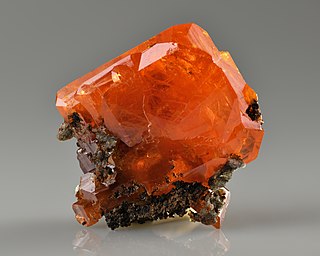
Wulfenite is a lead molybdate mineral with the formula PbMoO4. It often occurs as thin tabular crystals with a bright orange-red to yellow-orange color, sometimes brown, although the color can be highly variable. In its yellow form it is sometimes called "yellow lead ore".
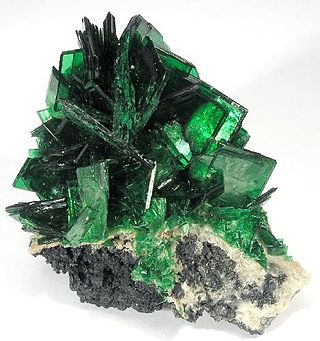
Torbernite, also known as chalcolite, is a relatively common mineral with the chemical formula Cu[(UO2)(PO4)]2(H2O)12. It is a radioactive, hydrated green copper uranyl phosphate, found in granites and other uranium-bearing deposits as a secondary mineral. The chemical formula of torbernite is similar to that of autunite in which a Cu2+ cation replaces a Ca2+ cation. Torbernite tends to dehydrate to metatorbernite with the sum formula Cu[(UO2)(PO4)]2(H2O)8.

Powellite is a calcium molybdate mineral with formula CaMoO4. Powellite crystallizes with tetragonal – dipyramidal crystal structure as transparent adamantine blue, greenish-brown, yellow-to-grey typically anhedral forms. It exhibits distinct cleavage, and has a brittle-to-conchoidal fracture. It has a Mohs hardness of 3.5 to 4 and a specific gravity of 4.25. It forms a solid solution series with scheelite (calcium tungstate, CaWO4). It has refractive index values of nω=1.974 and nε=1.984.
Molybdenum trioxide describes a family of inorganic compounds with the formula MoO3(H2O)n where n = 0, 1, 2. The anhydrous compound is produced on the largest scale of any molybdenum compound since it is the main intermediate produced when molybdenum ores are purified. The anhydrous oxide is a precursor to molybdenum metal, an important alloying agent. It is also an important industrial catalyst. It is a yellow solid, although impure samples can appear blue or green.
Mosesite is a very rare mineral found in few locations. It is a mercury mineral found as an accessory in deposits of mercury, often in conjunction with limestone. It is known to be found in the U.S. states of Texas and Nevada, and the Mexican states of Guerrero and Querétaro. It was named after Professor Alfred J. Moses (1859–1920) for his contributions to the field of mineralogy in discovering several minerals found alongside mosesite. The mineral itself is various shades of yellow and a high occurrence of spinel twinning. It becomes isotropic when heated to 186 °C (367 °F).

Schröckingerite is a radioactive yellow uranium-containing carbonate mineral, hydrated sodium calcium uranyl sulfate carbonate fluoride. Schröckingerite crystallizes in the orthorhombic system, occurring as globular clusters, and fluoresces yellow-green under ultraviolet light.

The sulfate minerals are a class of minerals that include the sulfate ion within their structure. The sulfate minerals occur commonly in primary evaporite depositional environments, as gangue minerals in hydrothermal veins and as secondary minerals in the oxidizing zone of sulfide mineral deposits. The chromate and manganate minerals have a similar structure and are often included with the sulfates in mineral classification systems.
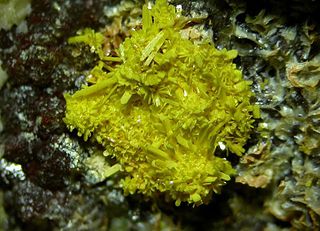
Bergenite is a rare uranyl phosphate of the more specific phosphuranylite group. The phosphuranylite-type sheet in bergenite is a new isomer of the group, with the uranyl phosphate tetrahedra varying in an up-up-down, same-same-opposite (uuduudSSOSSO) orientation. All bergenite samples have been found in old mine dump sites. Uranyl minerals are a large constituent of uranium deposits.
Rameauite is a hydrated complex uranyl oxide mineral with formula K2Ca(UO2)6(OH)16·H2O or K2CaU6+6O20·9H2O.
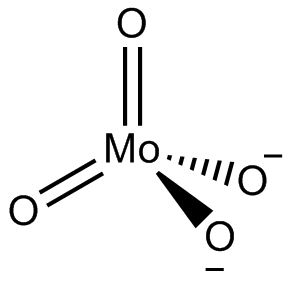
In chemistry, a molybdate is a compound containing an oxyanion with molybdenum in its highest oxidation state of +6: O−−Mo(=O)2−O−. Molybdenum can form a very large range of such oxyanions, which can be discrete structures or polymeric extended structures, although the latter are only found in the solid state. The larger oxyanions are members of group of compounds termed polyoxometalates, and because they contain only one type of metal atom are often called isopolymetalates. The discrete molybdenum oxyanions range in size from the simplest MoO2−
4, found in potassium molybdate up to extremely large structures found in isopoly-molybdenum blues that contain for example 154 Mo atoms. The behaviour of molybdenum is different from the other elements in group 6. Chromium only forms the chromates, CrO2−
4, Cr
2O2−
7, Cr
3O2−
10 and Cr
4O2−
13 ions which are all based on tetrahedral chromium. Tungsten is similar to molybdenum and forms many tungstates containing 6 coordinate tungsten.

Derriksite is a very rare uranium mineral with the chemical formula Cu4(UO2)(SeO3)2(OH)6•H2O. It is a secondary mineral that contains copper, uranium and the rarer selenium. It is a bright green to duller bottle green colour. Its crystal habit is acicular, it is most likely to be found along with the uranyl selenium mineral demesmaekerite, but derriksite is much rarer than demesmaekerite. It is named after Jean Marie Francois Joseph Derriks (1912–1992), geologist and administrator of the Union Minière du Haut Katanga (UMHK). It has a Mohs hardness of about 2.

Ferrimolybdite is a hydrous iron molybdate mineral with formula: Fe3+2(MoO4)3·8(H2O) or Fe3+2(MoO4)3·n(H2O). It forms coatings and radial aggregates of soft yellow needles which crystallize in the orthorhombic system.
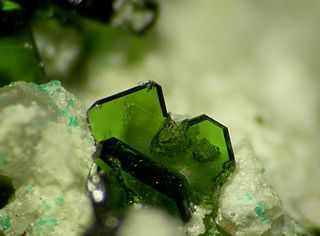
Lindgrenite is an uncommon copper molybdate mineral with formula: Cu3(MoO4)2(OH)2. It occurs as tabular to platey monoclinic green to yellow green crystals.
Ichnusaite (pronounced iknusa-ait) is a very rarely found mineral. Ichnusaite is a natural compound of thorium and molybdenum with the formula Th(MoO4)2·3H2O. It was discovered in Su Seinargiu, Sarroch, Cagliari, Sardegna, Italy in 2013. The name is from the old Greek name of Sardinia, Ιχνουσσα, Ichnusa.
This locality is also a place of discovery of the second natural thorium molybdate - nuragheite.
Tancaite-(Ce) is a very rare molybdate mineral with the formula FeCe(MoO4)3•3H2O. It was found in Punta de Su Seinargiu locality on Sardinia, Italy. Red crystals of tancaite-(Ce) resemble modified cubes, but the mineral is trigonal (space group R-3). The type locality of tancaite-(Ce) is also a place of discovery of other molybdate minerals, including thorium molybdates ichnusaite and nuragheite.
Nuragheite is a rare natural thorium molybdate, formula Th(MoO4)2·H2O, discovered in Su Seinargiu, Sarroch, Cagliari, Sardegna, Italy. This locality is also a place of discovery of the other thorium molybdate - ichnusaite, which is a trihydrate.
Peggy-Kay Hamilton (1922–1959) was born in Illinois in 1922 and was an American Research Associate in Mineralogy in the Department of Geology at Columbia University. One of Hamilton's first research breakthroughs was developing Research Project 49, otherwise known as the study of clay minerals. In her later research years, her focus shifted and led to her becoming involved full time in the study of uranium.
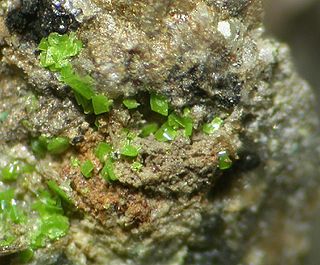
Sengierite is a rare oxide and hydroxide mineral, chemically a copper and uranyl vanadate, belonging to the carnotite group. Its chemical formula is Cu2(OH)2[UO2|VO4]2·6H2O.












